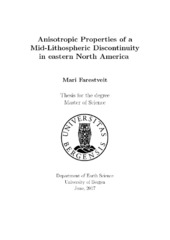| dc.description.abstract | During the last few years the occurrence of a mid-lithospheric discontinuity (MLD) has been observed in lithospheric studies of cratons. Studies using receiver functions have focused mainly on extracting high resolution information about the depth and extent of this discontinuity. Surface wave studies detect a change in anisotropy occurring over the same interval where the MLD is mapped, but no one has yet investigated whether these two features actually coincide. The nature of the MLD could therefore be anisotropic. In this thesis I use an new database of earthquake recordings to investigate the MLD in eastern North America. The focus is primarily on station HRV near Boston, containing 486 receiver functions with good backazimuthal coverage. Through forward modeling of receiver functions and harmonic decomposition, I find that the best fit to the MLD at HRV is obtained without a velocity reduction, but with a change in anisotropy. A change from a horizontal axis of anisotropy to a plunging axis provides the simplest model to reproduce the observed HRV data. I attribute this change of anisotropy to a division between ”frozen-in” anisotropy from the formation of the Appalachian chain in the upper lithosphere, and reworked fabric in the lower lithosphere from heating by the mantle plume of the Great Meteor hotspot. This interpretation implies that the fabric in the lower lithosphere is a localized phenomenon, which should be distinguished from the craton-wide MLD signal observed in North America. Regional profiles indicate a reduction of MLD signal strength towards the craton, suggesting that the lower lithospheric layer mapped in previous craton wide studies does not extend outside the craton boundaries. However, such an interpretation cannot be based on only one station, and should be tested with an expanded study of the entire eastern North America using semi-automated inversion methods. | en_US |
